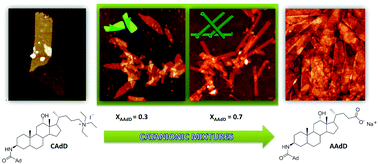Bile acid derivative-based catanionic mixtures: versatile tools for superficial charge modulation of supramolecular lamellae and nanotubes†
Abstract
Self-assembled structures formed by mixtures of cationic and anionic surfactants are interesting tools for applications requiring interactions with charged particles and molecules. Nevertheless, they present instability close to the equimolar composition and poor morphological versatility, which is generally restricted to vesicles and micelles. Against this general trend, we report on bile salt derivative based catanionic mixtures assembling in tubules and lamellae depending on the mixture composition. Electrophoretic mobility measurements prove that the composition also dictates their superficial charge, which can be tuned from negative to positive by increasing the positively charged surfactant fraction in the mixtures. The study of the catanionic aggregates was conducted by means of microscopy and spectroscopy techniques and compared to the self-assembly behaviors of the individual building blocks. This study broadens the so far small array of bile salt derivative catanionic systems, confirming their distinctive behavior in the spectrum of catanionic mixtures.

- This article is part of the themed collection: 2018 PCCP HOT Articles


 Please wait while we load your content...
Please wait while we load your content...